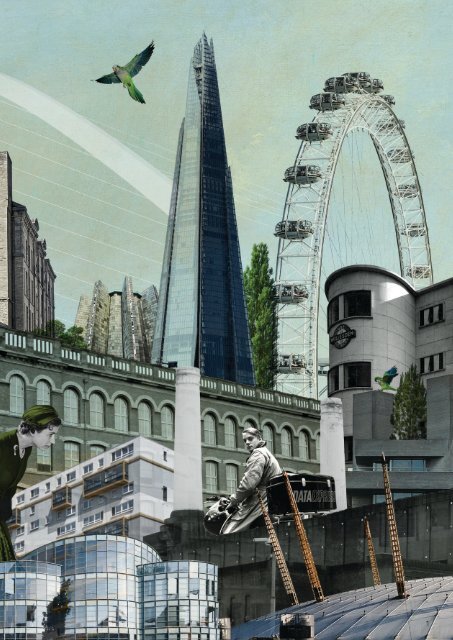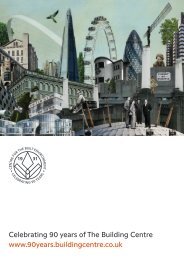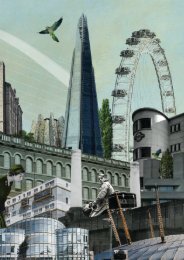BC Displays A4 PDF v3
Create successful ePaper yourself
Turn your PDF publications into a flip-book with our unique Google optimized e-Paper software.
1
BUILDING CENTRE 1931-2021<br />
In a major initiative that the Built<br />
Environment Trust has planned to mark<br />
the 90th anniversary of the Building<br />
Centre, and to highlight the remarkable<br />
achievements of the built environment<br />
in this period, we have invited leading<br />
figures in Britain - from architects,<br />
engineers, planners and developers<br />
to actors, architectural historians,<br />
photographers, broadcasters, writers<br />
and artists - to select what to them<br />
represents the best examples of our<br />
nation’s built environment.<br />
This is not intended as a dry<br />
and dusty architectural critique,<br />
rather to explore though the<br />
contributors what significance<br />
their selection has for them. This<br />
is not just about buildings - the<br />
Built Environment is so much<br />
more than that. Our selectors<br />
were free to choose urban<br />
green spaces, sculpture parks,<br />
iconic structures, repurposed<br />
industrial buildings, public<br />
buildings, public houses,<br />
libraries, galleries, theatres,<br />
places of worship. The only<br />
criterion was that it must be<br />
something that resonated<br />
strongly with them.<br />
2
Contents<br />
4 Overview<br />
6 History of The Building Centre 1931-1959<br />
8 History of The Building Centre 1960-2021<br />
10 1930s<br />
12 1940s<br />
14 1950s<br />
16 The Festival of Britain<br />
18 1960s<br />
20 Leslie Martin and Sadie Speight<br />
22 1970s<br />
24 1980s<br />
26 1990s<br />
28 Zaha Hadid<br />
30 2000s<br />
32 2010s<br />
34 Celebrating 90 Years of The Built Environment<br />
36 The Future<br />
3
BUILDING CENTRE 1931-2021<br />
To celebrate our 90 year<br />
anniversary we invited 90<br />
people to nominate 90<br />
buildings or developments<br />
that have been created or<br />
repurposed since 1931<br />
The only criteria was that it must be something<br />
that truly touched and impacted on their lives<br />
Selections and selectors<br />
From public buildings to public houses, libraries<br />
to art galleries, repurposed industrial buildings<br />
to theatres, we showcase the best the built<br />
environment has to offer. Our selectors include<br />
some well known faces, from the world of<br />
architecture through to celebrities.<br />
Get involved<br />
Over the coming months both the selections<br />
and their selectors will appear on our website<br />
and through social media. We will also be<br />
inviting you to pick your own favourite - either<br />
from voting for one of their selections or by<br />
choosing one of your own - or both!<br />
www.90years.buildingcentre.co.uk<br />
#90Buildings<br />
4
Founded in 1931, the Building Centre<br />
started life as a building materials bureau<br />
at the Architectural Association with<br />
the aim of demonstrating to students<br />
and architects the best contemporary<br />
products and materials available.<br />
The Building Centre logo was designed by the<br />
highly acclaimed Milner Grey, one of the key<br />
figures of British industrial design in the 20th<br />
century, having played an important role in<br />
establishing design as a recognised profession.<br />
The pioneer graphicist Milner Gray was born<br />
into the Arts and Crafts movement and was<br />
one of the few who were able to bridge the<br />
gap between that movement and today’s<br />
computerised design businesses. Throughout<br />
his life he remained loyal to the movement’s<br />
ethics and deep respect for craftsmanship<br />
and materials.<br />
The striking design works as a simple graphic<br />
device which has somehow stood the test of<br />
time, working as well today as when it was<br />
originally designed.<br />
The Building Centre formally opened to the public<br />
on September 7th 1932, with Frank Yerbury as<br />
its managing director. It opened in Bond Street,<br />
at the heart of London’s fashionable West End<br />
shopping district, and across four floors displayed<br />
the latest building products.<br />
Shows such as the Daily Mail Ideal Home Show<br />
had already demonstrated that women were very<br />
interested in domestic fixtures, and not just home<br />
furnishings, and the industry was waking up to the<br />
fact that the reactions of female consumers could<br />
be vital to selling their products. Yerbury was an<br />
architectural photographer and secretary of the<br />
Architectural Association School. When the Centre<br />
opened he became Managing Director, a post he<br />
held until 1961. Despite his lack of formal training<br />
he was a charismatic and influential figure,<br />
introducing leading architects in to the Centre,<br />
including Basil Spence and Giles Gilbert Scott.<br />
The Building Centre poster<br />
Frank Yerbury under the Railings for Scrap sign, 1940 © RIBA<br />
5
BUILDING CENTRE 1931-2021<br />
History of The Building<br />
Centre 1931-1959<br />
Key moments in the history of The Building Centre 1931-1959<br />
1931<br />
The Building Centre is founded<br />
1932<br />
The Building Centre opens in Bond Street, and<br />
Frank Yerbury appointed managing director.<br />
The first exhibition staged there is Yerbury’s<br />
photography of Soviet architecture.<br />
1933<br />
The Building Centre secures support from the<br />
Prince of Wales to launch the seminal low-cost<br />
housing exhibition of three-bedroom cottages.<br />
These semi-detached houses built for less<br />
than £500 are put up in London’s Aldwych and<br />
visited by 20,000 people.<br />
Low cost housing in the Aldwych<br />
6
1939<br />
‘Women in Architecture’ exhibition of<br />
photographs and models of buildings by<br />
women architects attracts press attention with<br />
features in the Daily Mirror, The Observer, Daily<br />
Herald and News Chronicle. The Mail headline<br />
is ‘WOMEN MAKE GOOD ARCHITECTS.’<br />
1950<br />
Store Street site acquired and structural<br />
work is undertaken to make changes from its<br />
previous life as a car showroom.<br />
Building Centre Information desk<br />
Architect Mary Medd looking at a model of R.E Sassoon House<br />
designed by Elizabeth Denby and Maxwell Fry<br />
Elizabeth Denby (1894-1965) became a<br />
significant figure in the world of housing<br />
and architecture in interwar England as an<br />
urban planner, reformer and campaigner.<br />
Most famously she worked with Maxwell Fry<br />
developing the programme for their pioneering<br />
flats, R. E Sassoon House in Peckham (1934) and<br />
Kensal House in Ladbroke Grove. (1937).<br />
1956<br />
The Information Service at the Building Centre<br />
is the largest in any industry in the UK, having<br />
received over 106,000 enquiries in the year.<br />
1941<br />
After a direct hit in 1941, the Building Centre<br />
is housed temporarily at 9 Conduit Street.<br />
1957 – An informal visit by Prince Philip,<br />
pictured with Giles Gilbert Scott and Frank Yerbury<br />
1959<br />
Store Street, London<br />
Le Corbusier exhibition<br />
is staged attracting<br />
37,000 visitors in 5 weeks.<br />
Frank Yerbury, a highly<br />
respected architectural<br />
photographer, had been<br />
the first to publish Le<br />
Corbusier’s early works.<br />
Talk series includes Jane Drew, Ernő<br />
Goldfinger and James Stirling.<br />
7
BUILDING CENTRE 1931-2021<br />
History of The Building<br />
Centre 1960-2021<br />
Key moments in the history of The Building Centre 1960-2021<br />
1961<br />
The Building Centre has gone global with the<br />
International Congress of Building Centres –<br />
to which over 60 Centres belong. That same<br />
year a brick library is set up showcasing an<br />
impressive 800 samples of brick from across<br />
England and Wales.<br />
1962<br />
A Hospital Equipment Register opens in<br />
the Building Centre. A cabinet contains<br />
photographs and written information on the<br />
complete range of materials and equipment<br />
suitable for hospital buildings.<br />
The Building Centre ‘Hospital.’<br />
Store Street Brick Library<br />
8
1966<br />
W A Balmain, a contractor at Turner & Newall,<br />
attends a system-building forum at the<br />
Building Centre where he highlights the<br />
lack of agreement of acceptable tolerances<br />
was “extremely urgent”. Two years later, the<br />
1968 Ronan Point tower block in east London<br />
collapses killing three people. Large gaps were<br />
later discovered in the joints that had failed to<br />
hold together the structural concrete panels.<br />
2007<br />
The Building Centre turns its attention to<br />
sustainability and in 2007 exhibits No.1 Lower<br />
Carbon Drive – a full scale model of a Victorian<br />
terraced house – in Trafalgar Square. The house<br />
showcases ways in which homes could be<br />
transformed to reduce CO 2 emissions.<br />
1970s<br />
‘Earth Day’ – a large-scale environmental<br />
protest on 22 April 1970 in the US. Public<br />
agency to protect the environment grows and<br />
organisations such as Friends of the Earth and<br />
Greenpeace, both founded in 1971, become<br />
leaders of the movement.<br />
1980s<br />
In response to the advances in technology<br />
the Building Centre adopts Infodisc, a new<br />
standalone technology that combines colour<br />
images and text.<br />
1990s<br />
The Centre publishes a report looking 10 years<br />
ahead to the future concluding that “by the<br />
end of the century contractors will be receiving<br />
project data on disc or by network. Robotics<br />
will require greater prefabrication.”<br />
The model Victorian terraced house<br />
2010-2021<br />
The Centre continues to welcome<br />
manufacturers and organisations to Store<br />
Street. Product Finder is used by a monthly<br />
audience of 45,000 unique professional<br />
specifiers to search 13,000 company profiles.<br />
Regular gallery exhibitions, on-line articles<br />
and talks open up conversations about<br />
the important subjects of sustainability,<br />
retrofitting, climate change and the impact<br />
that the construction industry has had on our<br />
carbon footprint. It also continues to highlight<br />
new, innovative materials and techniques that<br />
will transform the way the built environment<br />
develops.<br />
2006<br />
Marking 75 years of the Centre a major new<br />
exhibition ‘Materials of Invention’ takes<br />
place charting major innovations in modern<br />
architecture, from the Festival of Britain to the<br />
Millennium Dome.<br />
9
BUILDING CENTRE 1931-2021<br />
1930s<br />
British architecture was pulled in different<br />
directions through this tense decade. As an<br />
imperial power, the language of classicism<br />
dominated public works, whilst Arts and<br />
Crafts informed domestic architecture.<br />
American ‘Art Deco’—inspired by new<br />
archaeological discoveries in Egypt—appeared<br />
in London and Liverpool, and European<br />
émigrés fleeing fascism promoted a new<br />
avant-garde ‘modernism’. And everyone used<br />
the new technologies of glass, steel, concrete<br />
and, most of all, electricity!<br />
De La Warr Pavillion<br />
Mendelshon, a Jewish émigré fleeing persecution<br />
in Nazi Germany, collaborated with Chermayeff for<br />
a leisure pavilion producing one of the first public<br />
buildings of recognisably modern design, utilising<br />
a welded steel frame and cantilevered reinforced<br />
concrete slabs to produce an open, light space.<br />
De La Warr Pavilion, Bexhill-on-Sea, East Sussex.<br />
Architects: Erich Mendelshon and Serge Chermayeff; Engineer: Felix Samuely; 1935<br />
10
Battersea Power Station<br />
Scott’s exterior of classical detailing and rigorous<br />
symmetry off-setting the monumental plain brick<br />
towers and walls, and Halliday’s Art Deco interiors, lent<br />
this massive utility building glamour and iconic status.<br />
Providing a fifth of London’s electricity it is functionally<br />
and representatively a symbol of modernity.<br />
The Hoover Building<br />
American manufacturers developed a number of<br />
factories across the north-west of London in the<br />
inter-war period. Hoover built theirs on Western<br />
Avenue—a major trunk road—and the fashionable Art<br />
Deco design, which uses stylised Egyptian motifs,<br />
acted as a gigantic advertisement for the company.<br />
Battersea Power Station, London.<br />
Architects: J Theo Halliday and Sir Giles Gilbert Scott; Main Contractor: John Mowlem<br />
and Co.; 1935 (Phase A) and 1941 (Phase B), completed 1955<br />
Hoover Building, Ealing, London.<br />
Architects: Wallis, Gilbert and Partners; 1938<br />
66 Portland Place (RIBA Headquarters)<br />
Wornum’s design contains elements of Art Deco,<br />
Swedish classicism, and touches of Arts and Crafts.<br />
Modern structural technologies (steel and concrete)<br />
are hidden by didactic iconography which relays<br />
an imperialist vision of architecture and Britain’s<br />
place in the world.<br />
Royal Shakespeare Theatre<br />
An original theatre of 1879 was destroyed by<br />
fire in 1926. Elisabeth Scott won an international<br />
competition, the first woman to design a major public<br />
building in England. Modern for the period, Scott<br />
treated the formal organisation of the building and<br />
materials (largely exposed brick) with a stark clarity.<br />
66 Portland Place (RIBA Headquarters), London.<br />
Architects: George Grey Wornum; Main Contractor: Ashby and Horner; 1934<br />
Royal Shakespeare Theatre, Stratford-upon-Avon.<br />
Architects: Scott, Chesterton and Shepherd; Main Contractor: G. E. Wallis and Sons Ltd.; 1932<br />
11
BUILDING CENTRE 1931-2021<br />
1940s<br />
Under conditions of total warfare<br />
building production became<br />
necessarily utilitarian. Architects and<br />
engineers working for government<br />
ministries produced a range of<br />
buildings: forts, barracks, offices,<br />
depots and air-hangars. The building<br />
industry was transformed, and general<br />
contractors invested in new industrial<br />
materials and techniques. Even in the<br />
darkest moments, architects worked<br />
on plans for the future—for housing<br />
and serving the people in peacetime.<br />
12
Arkon MkV<br />
Prefabricated bungalows—manufactured in<br />
workshops and delivered on to sites as whole or<br />
part finished units—was identified as a means to<br />
solve immediate housing shortages at the end of the<br />
Second World War. Architects Edric Neel, Rodney<br />
Thomas, Raglan Squire and designer Jack Howe<br />
designed the Arkon MkV.<br />
Shivering Sands Army Fort<br />
The Admiralty invited Guy Anson Maunsell to design<br />
several anti-aircraft towers for the estuaries of<br />
the Mersey and Thames. Maunsell designed these<br />
as interconnected platforms, using a modular<br />
construction system of reinforced concrete and steel.<br />
Built at Red Lion Wharf and shipped to position, the<br />
army forts were decommissioned in the 1950s.<br />
Arkon MkV, Avoncroft Museum of Historic Buildings, Bromsgrove.<br />
Architects: Arcon (Architectural Consultants)<br />
Manufacturers: Arcon (later absorbed into Taylor Woodrow); c.1945.<br />
Shivering Sands Army Fort, Thames Estuary.<br />
Engineers: Maunsell and Sir Alexander Gibb and Partners;<br />
Main Contractor: Holloway Brothers (London) Ltd; 1943<br />
D Block Bletchley Park<br />
For its role in the war effort, and as the birthplace<br />
of the digital computer, Bletchley Park is historically<br />
significant. But the same brick structure, and<br />
concrete roof, of this ‘spider-block’ is also an<br />
example of the rationalised system building that<br />
dominated wartime construction.<br />
Cornish Unit Type 1 House<br />
An alternative to prefabricating housing was<br />
standardised prefabricating elements. The Cornish<br />
Unit Type 1 House utilised pre-reinforced concrete<br />
frame and precast concrete panels which could be<br />
fixed in situ (on site). The expected improvements<br />
in quality control and costs proved chimerical and<br />
this system—as with many others in the period—was<br />
eventually abandoned.<br />
D Block, Bletchley Park, Milton Keynes.<br />
Design: Ministry of Works and Planning (standard design for temporary office buildings); 1943<br />
Cornish Unit Type I House.<br />
Designers: A E Beresford and R Tonkin; Manufacturer: Central Cornwall Concrete and<br />
Artifical Stone Co./Selleck Nicholls and Co.; c.1946<br />
13
BUILDING CENTRE 1931-2021<br />
1950s<br />
Post-war Britain’s reconstruction<br />
was a transformation: a political<br />
consensus guaranteed welfare,<br />
housing, education, a health service,<br />
and work for all. The architect<br />
and engineer became servants<br />
of the state. Schools, hospitals,<br />
and housing, were designed by a<br />
generation of modernists with a faith<br />
in technological and social progress.<br />
By the mid-1950s a younger,<br />
emboldened group, produced radical<br />
architectural works that would grab<br />
the attention of the world.<br />
14
Royal Festival Hall,<br />
The only permanent building of the Festival of<br />
Britain Southbank Exhibition, the Festival Hall<br />
auditorium is suspended like an ‘egg-in-a-box’ by a<br />
cluster of reinforced concrete columns. This insulates<br />
the hall from environmental noise, but also creates<br />
one of the best public foyer spaces in London.<br />
Harlow New Town<br />
Much of post-war reconstruction rested on<br />
the assumption that London—economically,<br />
demographically, and physically—needed to<br />
shrink. As a result, a ring of ‘New Towns’ were<br />
proposed, planned and built from the 1940s until<br />
the 1970s (Milton Keynes was the last). Harlow<br />
is typical, with its mix of modernist design<br />
tempered by a Garden City ideal.<br />
Royal Festival Hall, London.<br />
Architects: London County Council Architect’s Department (Robert Matthew, Leslie Martin,<br />
Peter Moro, Edwin Williams); Main Contractor: Holland & Hannen and Cubitts London, 1951<br />
Harlow New Town, Harlow Development Corporation<br />
(Frederick Gibberd Architect-Planner), from 1947<br />
Churchill Gardens<br />
A pioneering example of ‘mixed development’<br />
housing, first recommended in the 1943 County of<br />
London Plan, Churchill Gardens provided 1,600 homes<br />
in tall and medium height slab blocks, maisonettes<br />
and terraces. The scheme originally included an<br />
accumulator tower which supplied heating and hot<br />
water drawn from Battersea Power Station.<br />
Golden Lane Estate<br />
An advanced example of ‘mixed development’<br />
housing provision. The architects Chamberlin,<br />
Powell & Bon would go on to design the gigantic<br />
Barbican Estate next-door. Here they produced an<br />
almost picturesque scheme with blocks of varying<br />
heights organised around courts—some of which<br />
are sunk to basement level.<br />
Churchill Gardens, London.<br />
Architects: Powell & Moya; Main Contractor: Holloway Bros; 1954.<br />
Golden Lane Estate, London.<br />
Architects: Chamberlin, Powell & Bon; Engineer: Ove Arup;<br />
Main Contractor: George Wimpey; 1957–1962<br />
15
BUILDING CENTRE 1931-2021<br />
The Festival of Britain<br />
Opening in May 1951<br />
and lasting until that<br />
September, the Festival<br />
of Britain was timed<br />
to coincide with the<br />
centenary of the Great<br />
Exhibition in 1851.<br />
16
Focused entirely on Britain<br />
In 1951 towns and cities across Britain still<br />
bore the devastating scars of the Second<br />
World War, and after more than a decade of<br />
rationing, austerity and making-do, gloomy<br />
post-war Britain needed a lift. The exhibition<br />
was designed to promote a feeling of recovery<br />
and demonstrate Britain’s contribution to past,<br />
present and future in the arts, science and<br />
technology and industrial design.<br />
The site chosen for the Festival was the South<br />
Bank of the Thames, previously derelict with<br />
railway sidings and old Victorian buildings<br />
and greatly damaged by wartime bombing.<br />
The total area of the site was around 27 acres,<br />
and included a new river wall which reclaimed<br />
over 4 acres from the Thames and enabled the<br />
future construction of an embankment walk.<br />
The new South Bank site was intended to<br />
showcase the principles of design that would<br />
feature in the post-war rebuilding of London,<br />
together with the creation of new towns<br />
around Britain.<br />
Although reactions to the Festival were<br />
mixed what it undoubtedly achieved was the<br />
complete change of character of the South<br />
Bank. The only permanent building was the<br />
Royal Festival Hall, but the area eventually<br />
developed into the South Bank Centre, an arts<br />
complex housing the Royal Festival Hall, the<br />
National Film Theatre, Queen Elizabeth Hall and<br />
the National Theatre.<br />
Southbank Arts Centre<br />
A complex of exhibition gallery, large concert<br />
hall, and small concert hall squat on the south<br />
bank of the Thames wrapped in concrete<br />
walk-ways. A classic example of ‘brutalism’,<br />
all ‘bêton brut’ (French for ‘raw concrete’),<br />
uncompromising forms and radical separation<br />
of functions (pedestrians from traffic; inside<br />
to outside; served and service spaces).<br />
Southbank Arts Centre, London.<br />
Architect: Greater London Council Architect’s Department;<br />
Main Contractor: Higgs and Hill; 1968<br />
17
BUILDING CENTRE 1931-2021<br />
1960s<br />
The confidence of modernist<br />
architects and planners grew in<br />
a period of sustained economic<br />
growth in the 1960s. The decade is<br />
marked by formal and programmatic<br />
experimentation in response to new<br />
pressures and problems: the private<br />
motorcar, deindustrialisation, and<br />
the need to conserve buildings and<br />
landscapes of historic significance.<br />
Paradoxically, as designers became<br />
more sensitive to popular cultures,<br />
the public experienced greater<br />
distance and disenfranchisement<br />
from architecture.<br />
18
Coventry Cathedral<br />
Coventry was severely bombed in the 1940s. Basil<br />
Spence won the open competition to rebuild the<br />
cathedral in 1951. The ruined shell of Saint Michael’s<br />
remains, the new design is at right angles. Though<br />
recognisably modern, the vault is decorative and the<br />
walls of stone. Spence supervised the selection of<br />
artists and works which are representative of midcentury<br />
decorative arts.<br />
St Catherine’s College Oxford<br />
A design of precision and formal rigour by the Danish<br />
architect Jacobsen. The quality of the concrete finish<br />
is extremely high—Jacobsen was exacting in his<br />
specifications (the prestressed structural beams had<br />
to be imported). He also designed or oversaw the<br />
selection of every detail—including furniture, cutlery,<br />
and planting of the gardens.<br />
Coventry Cathedral, Coventry.<br />
Architect: Sir Basil Spence; Engineer: Ove Arup; Main Contractor: John Laing, 1962.<br />
St Catherine’s College Oxford, Oxford.<br />
Architect: Arne Jacobsen; 1964<br />
University of Leicester Engineering Building<br />
James Stirling and James Gowan were young<br />
architects when Leslie Martin advised the<br />
Engineering Department at University of Leicester<br />
to accept their competition entry. They produced an<br />
architecture of daring and maturity, with a formal<br />
composition that captured world attention, its<br />
concrete frame covered with red brick and tile and<br />
aluminium frame glazing.<br />
Apollo Pavilion<br />
A sculpture by an artist with a history of architectural<br />
collaborations. The abstract work of cantilevered<br />
concrete slabs (cast in situ) generating cubic forms is<br />
almost unique in Britain. It is erected at the centre of<br />
the troubled Peterlee new town development.<br />
Apollo Pavilion, Peterlee.<br />
Artist: Victor Passmore. 1969<br />
University of Leicester Engineering Building, Leicester.<br />
Architects: Stirling and Gowan; Engineer: F J Samuely & Partners (Frank Newby); 1963<br />
19
BUILDING CENTRE 1931-2021<br />
Leslie Martin and<br />
Sadie Speight met at the<br />
School of Architecture,<br />
University of Manchester<br />
in 1926. They would go<br />
on to leave an indelible<br />
mark on modern<br />
architecture in Britain.<br />
20
Sir Leslie Martin (1908–2000) and Sadie Speight (1906–1992)<br />
The Architects<br />
Martin and Speight became engaged in 1927,<br />
began their practice in 1933 and married<br />
in 1935. In 1939 Speight joined the Design<br />
Research Unit, a highly influential design<br />
consultancy.<br />
In 1948 Martin was brought into the largest<br />
architectural practice in the world at that<br />
time: the Architect’s Department of the<br />
London County Council, then led by Robert<br />
Matthew. He was soon leading the team—with<br />
Matthew, Peter Moro, and Edwin Williams—<br />
that produced the Royal Festival Hall, the<br />
first post-war modern building to receive a<br />
Grade 1* listing. Martin was in full sympathy<br />
with Matthew’s project to transform the<br />
department through the appointment of young,<br />
talented modernists, working in groups to a<br />
non-dogmatic, but rigorous design agenda,<br />
resulting in Martin’s promotion to Architect to<br />
the Council when Matthew left in 1953.<br />
The Work<br />
Martin and Speight’s designs appear almost<br />
to recede into the background of the British<br />
landscape they are so ‘normal’—though they<br />
often sparked controversy, as all modernist<br />
work did, in the mid-twentieth century. This<br />
cannot be because of ubiquity. Instead, it<br />
is down to the extraordinary influence they<br />
exerted on the architecture and design<br />
establishment, through education and<br />
consultation. Both Martin and Speight wrote,<br />
edited, and designed numerous publications<br />
setting out the agenda, motive, and nature of<br />
modernism in Britain. Widely used as an advisor<br />
and judge for major competitions (particularly<br />
by universities) Martin succeeded, through his<br />
Chair at Cambridge, in shepherding more than<br />
one generation of architectural educators into<br />
key positions of influence.<br />
In 1956 Martin accepted the Chair of<br />
architecture at Cambridge, and moved there<br />
with Speight. They established an architectural<br />
practice grounded in collaboration—Speight,<br />
continued her own design practice throughout<br />
the 1950s and 1960s, concentrating on<br />
exhibition, product and print design.<br />
In his ‘Buildings and Ideas’ book Martin wrote<br />
“Sadie Speight has made her own very special<br />
contribution to my work throughout the whole<br />
of my professional career.’’<br />
Leslie Martin, Frank Lloyd Wright, R. Furneaux and Leo de Syllas<br />
outside County Hall, 1950. © RIBA<br />
21
BUILDING CENTRE 1931-2021<br />
1970s<br />
Confidence in modernism in Britain<br />
was undermined in the 1970s. A<br />
series of economic crises radically<br />
increased the cost of energy and<br />
wages. Scandals and disasters in the<br />
construction industry, the success<br />
of the conservation movement, and<br />
growing suspicion of technocratic<br />
planning put the authority of modern<br />
planners and architects to the test.<br />
As projects begun in the 1960s<br />
staggered to completion, new ideas<br />
emerged, centred on social values<br />
and participation.<br />
22
Dawson’s Heights<br />
By the mid-1960s architects were working<br />
to contradictory briefs from central and local<br />
government: more housing, more space per unit,<br />
less height, less ‘luxury’. Lead architect Macintosh<br />
(only 26 when she started this project) produced<br />
ingenious solutions in this complex of different<br />
housing units, all with balconies, all fully<br />
articulated on the hillside.<br />
The Piece Hall<br />
Restoration of this rare example of an 18th century<br />
cloth trading hall began in 1972. 19th century<br />
additions were demolished, the buildings carefully<br />
restored and the courtyard re-landscaped. The result<br />
is a fine example of late 20th century conservation.<br />
The Piece Hall, Halifax.<br />
Halifax Corporation. 1976<br />
Dawson’s Heights, London.<br />
Architects: Southwark Borough Council (lead architect Kate Macintosh); 1972<br />
National Theatre<br />
Often described as ‘brutalist’, it is, nevertheless,<br />
regarded as one of the most refined examples of<br />
modernist architecture in Britain. Though the concrete<br />
has a boarded finish, this is achieved to a precise<br />
standard. The cantilevered concrete ‘strata’ produce a<br />
landscape within which the three auditoria sit.<br />
Central London Mosque<br />
Gibberd’s design is caught between modernism and<br />
historicism for this prominent mosque. A Persian (but<br />
not onion) dome rests directly on a concrete ring,<br />
which is supported in turn by four columns, providing<br />
a large open prayer hall and largely glazed walls. The<br />
minaret is a single tube of reinforced concrete.<br />
Central London Mosque, London.<br />
Architect: Sir Frederick Gibberd; Main Contractor: John Laing PLC; 1977<br />
National Theatre, London.<br />
Architects: Denys Lasdun & Partners; Structural; Engineers: Flint; Main Contractor: AELTC. 1976<br />
23
BUILDING CENTRE 1931-2021<br />
1980s<br />
Radical political changes transformed<br />
architectural production in the 1980s.<br />
State sponsored construction collapsed,<br />
entrepreneurialism was championed and<br />
professionalism critiqued. ‘Post-modernism’,<br />
an often playful sometimes ironic approach,<br />
drew on historical and pop cultural motifs;<br />
‘High-Tech’ injected aesthetic value into<br />
the structural and servicing elements of a<br />
building. Meanwhile, ethically-informed<br />
architects directly engaged with communities<br />
marginalised by state and markets<br />
‘Temple of Storms’,<br />
Isle of Dogs Pumping Station<br />
Outram’s design for a water pumping station in the<br />
Isle of Dogs deliberately recalls the attention to<br />
detail paid by Victorian engineers in their designs<br />
for utility buildings. Every element, whilst remaining<br />
fully functional, references historic architecture,<br />
generating a mythic-poetic quality.<br />
‘Temple of Storms’, Isle of Dogs Pumping Station, London.<br />
Architect: John Outram Associates; Engineers: Sir William Halcrow and Partners; 1988<br />
24
Lloyd’s Building<br />
Many were surprised at the selection of High-<br />
Tech architect Rogers by the venerable insurance<br />
institution Lloyd’s of London. All services are placed<br />
on the outside of the building. Functionally this freed<br />
the interior to be completely open-plan. It gave<br />
London an icon.<br />
Broadgate Arena<br />
An example of ‘post-modern’ urban design and<br />
development. Arup generated a form reminiscent of<br />
classical monuments (think the Colosseum of Rome)<br />
providing much needed retail, leisure, and public<br />
spaces for the many office workers of the newly<br />
developed high-density Liverpool Street Station site.<br />
Lloyd’s Building, London.<br />
Architect: Richard Rogers and Partners; Structural and Services Engineer: Arup;<br />
Main Contractor: Bovis; 1986<br />
Broadgate Arena, London.<br />
Architects: Arup Associates; 1984<br />
Eldonian Village<br />
Facing the ravages of de-industrialisation and no<br />
state support, the former industrial community of<br />
Vauxhall, Liverpool, formed their own development<br />
co-operative. The former Tate & Lyle sugar refinery<br />
site was chosen for a housing scheme that included a<br />
number of innovative community-oriented features.<br />
Jagonari Educational Resource Centre<br />
The initial project for a resource centre serving the<br />
Bengali women of Tower Hamlets was begun in<br />
1982. Matrix—a feminist design co-operative—were<br />
appointed in 1984. The design is the product of close<br />
consultation work between Matrix and the local<br />
women who would use the building.<br />
Eldonian Village, Liverpool.<br />
Architects: Wilkinson Hindle Halsall Lloyd; from 1987<br />
Jagonari Educational Resource Centre, London.<br />
Architects: Matrix Feminist Design Co-operative; Consulting Engineers: Alan Baxter &<br />
Associates; Main Contractors: Laing Construction Ltd.; 1987<br />
25
BUILDING CENTRE 1931-2021<br />
1990s<br />
As economic globalisation consolidated—<br />
driven by finance, information<br />
technologies, and the new markets<br />
of post-socialist Eastern Europe and<br />
Russia—architecture in Britain developed<br />
a distinctly glossy sheen. In the last<br />
decade of the century many architects<br />
retreated from the wilder forms and pop<br />
references of postmodernism, and High<br />
Tech quieted to a rational engineering<br />
indistinguishable from modernism.<br />
Stansted Airport<br />
Foster was commissioned to design a new terminal<br />
building at Stansted in 1981. His approach was to<br />
return to essentials—moving passengers with ease<br />
and comfort through a highly legible space from<br />
set-down to plane by placing services beneath the<br />
main concourse and inside the structural ‘trees’.<br />
Stansted Airport, Stansted.<br />
Architect: Foster and Partners; Structural Engineer: Ove Arup and Partners;<br />
General Contractor: Laing Management Contracting Ltd, BAAC; 1991<br />
26
Waterloo International Railway Station<br />
A complex and restrictive site led Grimshaw to a<br />
highly satisfying structural solution. Repeating<br />
asymmetric ‘bow string’ arches support glazing<br />
held in place by ‘concertina’ gaskets – allowing<br />
repetitive tiles to cover a complex curve.<br />
All services are beneath the rail track.<br />
The British Library<br />
The largest public building of the twentieth century<br />
took more than 30 years to conclude and attracted<br />
much criticism, largely due to the ambiguity of its<br />
appearance: Was it pastiche, kitsch, critique or<br />
essay? Regardless, the attention to detail by the<br />
architects mean that it is likely to endure, with<br />
readers impressed by the comfort, balance, light<br />
and clarity of the interiors.<br />
Waterloo International Railway Station, London.<br />
Architect: Grimshaw Architects; Civil Engineers: Alexander Gibb and Partners;<br />
Main Contractor: Bovis; 1993<br />
The British Library, London.<br />
Architect: Colin St John Wilson & Partners; Structural Engineer: Arup;<br />
Main Contractor: John Laing, 1997<br />
OXO Tower Wharf Refurbishment<br />
A successful community campaign to retain many<br />
of the features of the flagship Oxo Tower, this<br />
redevelopment includes workshops for artists and<br />
designers and leisure facilities. Liebig, the original<br />
owner, had wanted to include a tower featuring<br />
illuminated signs advertising his product, OXO.<br />
When permission was refused the tower was built<br />
with four sets of three vertical windows, each<br />
of which just happened to be in the shapes of a<br />
circle, a cross and a circle!<br />
Media Centre<br />
Amanda Levete, David Miller and Jan Kaplicky<br />
produced a design and production process unique,<br />
iconic, and futuristic for one of the most conservative<br />
institutions in Britain: the Marylebone Cricket Club.<br />
Part manufactured in a shipyard, the Media Centre<br />
provides viewing banks with all cabling hidden inside<br />
the monocoque (ribbed) aluminium shell.<br />
Oxo Tower Wharf Refurbishment, London.<br />
Architect: Lifshutz Davidson Sandilands; Engineer: Buro Happold/Cundall Johnston &<br />
Partners; Main Contractor: Trollope and Colls; 1997<br />
Media Centre, Lord’s Cricket Ground, London.<br />
Architect: Future Systems; Structural Engineer: Ove Arup & Partners;<br />
Main Contractor: Pendennis Shipyard; 1999<br />
27
BUILDING CENTRE 1931-2021<br />
Zaha Hadid was a<br />
British Iraqi architect,<br />
artist and designer,<br />
recognised as one of the<br />
most important figures<br />
in architecture of the<br />
late 20th and early 21st<br />
centuries. She was also<br />
the first woman to win<br />
the RIBA Gold Medal,<br />
and to be awarded the<br />
Pritzker Prize.<br />
28
Dame Zaha Mohammad Hadid (1950-2016)<br />
The Architect<br />
She was born in Baghdad, Iraq, in 1950,<br />
and studied mathematics at the American<br />
University of Beirut before moving to London<br />
in 1971 to attend the Architectural Association<br />
school where she received the Diploma<br />
Prize in 1977.<br />
She taught at the school for a further 10 years,<br />
and during that time held numerous chairs and<br />
guest professorships. She founded Zaha Hadid<br />
Architects in 1979.<br />
She received the prestigious Stirling prize in<br />
2010 ( for the MAXXI in Rome) and in 2011 for<br />
the Evelyn Grace Academy in Brixton.<br />
Brixton.<br />
The Evelyn Grace Academy follows the<br />
principle of schools within schools, the four<br />
schools being incorporated within a design<br />
that generates natural division within highly<br />
functional spaces, while at the same time each<br />
school retains its own identity.<br />
The Work<br />
Zaha Hadid’s futuristic architecture is<br />
characterised by curving facades which appear<br />
soft and yet use strong materials.<br />
She has been described as “The Queen of<br />
the Curve” (The Guardian), and her major<br />
works include the London Aquatics Centre<br />
for the 2012 Olympics. She herself described<br />
the London Aquatics Centre as “inspired by<br />
the fluid geometry of water in movement.” An<br />
incredibly complex design, it was much praised<br />
by architectural critics, and was popular with<br />
participants and spectators alike.<br />
The undulating roof sweeps up from the<br />
ground like a wave, enclosing the two pools<br />
and blending perfectly with the surrounding<br />
environment of the Olympic Park.<br />
Other notable buildings in the UK: Serpentine<br />
Sackler North Gallery in Kensington Gardens<br />
and 33-35 Hoxton Square. The start point for<br />
the design of Hoxton Square is a prism, which<br />
allows for the manipulation of daylight, the<br />
interwoven panel and overall shape ensuring<br />
that neighbouring buildings also had access to<br />
natural light.<br />
29
BUILDING CENTRE 1931-2021<br />
2000s<br />
The turn of the century marked a highpoint<br />
in architectural production. Hundreds of<br />
major projects were completed utilising new<br />
digital design and manufacturing techniques.<br />
Devolution and a belief that cultural facilities<br />
would drive the ‘information economy’,<br />
often backed by controversial public–<br />
private finance initiatives, resulted in new<br />
developments around the country. Beyond<br />
these big projects, architects sought to<br />
develop new public spaces for increasingly<br />
multi-cultural urban centres.<br />
Westminster London Underground Station<br />
A restricted site servicing the deepest point of the<br />
London tube network could have resulted in a warren<br />
of passageways. Instead, Hopkins proposed an open<br />
‘elevator box’ design. Escalators, lifts and platforms<br />
are suspended within the open box of diaphragm<br />
walling, supported by lateral steel struts. The result is<br />
an underground station that is open and exhilarating.<br />
Westminster London Underground Station, London.<br />
Architect: Hopkins Architects; Consulting Engineer: Maunsell Ltd;<br />
Main Contractor: Balfour Beatty/AMEC Joint Venture; 1999/2000<br />
30
Eden Project<br />
Inspired by polymath Buckminster Fuller’s geodesic<br />
domes, Grimshaw designed two ‘Biomes’ (one<br />
for a rainforest environment, the other for a<br />
Mediterranean environment) that are so light they<br />
are tied, rather than resting, on the clay mines<br />
beneath. The membrane of each Biome consists of<br />
three layers of ETFE—one of the few plastics widely<br />
used as a covering in construction.<br />
Scottish Parliament Building<br />
A complex building form matched by a complex<br />
procurement history. Spanish architect Enric Miralles<br />
died in 2000, only two years into construction of his<br />
vision; his widow Benedetta Tagliabue became lead<br />
architect. The steel frame supports panels of granite<br />
and oak sourced from Scotland, representing the<br />
national landscape.<br />
Eden Project, Cornwall.<br />
Architect: Grimshaw Architects; Main contractor: Sir Robert McAlpine;<br />
Biome Construction: MERO (UK) Ltd.; 2001<br />
Scottish Parliament Building, Edinburgh.<br />
Architect: EMBT/RMJM; Structural Engineer: Arup; Main Contractor: Bovis Lend Lease; 2004<br />
The Senedd Building<br />
Rivington Place<br />
The first publicly funded arts space in London since<br />
1968, Rivington Place supports work by artists from<br />
culturally diverse backgrounds, and includes the<br />
Stuart Hall Library, the Institute of International<br />
Visual Art, and Autograph ABP. A concrete frame<br />
supports pre-cast panels that, through proportions<br />
and arrangement, generate complex interior spaces<br />
and perspectival illusions.<br />
An enormous, but light, steel frame, timber canopy<br />
is supported on slender columns, beneath which<br />
an envelope of glass contains the three-level Welsh<br />
Assembly. The circular debating chamber is formed<br />
by a timber cone, which draws down light, air, and<br />
captures rainwater which is recycled into services.<br />
The Senedd Building, Cardiff.<br />
Architect: Rogers Stirk Harbour + Partners; Structural Engineer: Arup;<br />
Main Contractors: Skanska and Taylor Woodrow; 2006<br />
Rivington Place, London.<br />
Architect: Adjaye Associates; Structural Engineer: Techniker Ltd;<br />
Main Contractor: Blenheim House Construction; 2008<br />
31
BUILDING CENTRE 1931-2021<br />
2010s<br />
While skyscrapers continue to rise in London,<br />
the construction industry has had to face<br />
up to significant problems. The Grenfell fire<br />
of 2017 proved the inadequacy of market<br />
regulation and the need for vastly improved<br />
professional oversight and ethical leadership.<br />
Construction and operation of buildings<br />
contributes nearly 40% of human greenhouse<br />
gas emissions. “Retrofit” new materials<br />
and construction processes, and design for<br />
‘passive operation’, are essential elements of<br />
any architecture of the future.<br />
The Shard<br />
The tallest European building outside of Russia,<br />
‘The Shard’ is a 72-storey skyscraper. The eight<br />
glazed facades reflect and refract day light, to<br />
produce an ambiguous visual presence. Symptomatic<br />
of the city’s development as a global financial centre<br />
the building now dominates London’s skyline.<br />
The Shard, London.<br />
Architect: Renzo Piano; Structural Engineer: Turner & Townsend, WSP Global,<br />
Robert Bird Group and Ischebeck Titan; 2012<br />
32
Mellor Primary School<br />
A small extension to a primary school adding a new<br />
library, classroom, special educational needs room, a<br />
library and cloakroom facilities. Conceived as a treehouse,<br />
the timber frame structure includes a raised<br />
deck that extends into the landscape and a ‘habitat<br />
wall’, made from found and recycled materials.<br />
Bloomberg Building<br />
The Bloomberg HQ attracted a great deal of<br />
attention—for its cost (estimates around £1 Billion),<br />
prestige (opposite the Bank of England and Wren’s<br />
St Stephen Walbrook), and for its environmental<br />
credentials. Lauded as a ‘sustainable’ building, large<br />
amounts of research have resulted in a technically<br />
sophisticated building, though its actual embodied<br />
carbon is likely to be very high.<br />
Mellor Primary School, Stockport.<br />
Architect: Sarah Wigglesworth Architects; Main Contractor: MPS Construction; 2015<br />
Cork House<br />
Assembled from CNC (computer-controlled)<br />
machined blocks of reconstituted cork—the<br />
bi-product of cork oak forestry and wine<br />
stopper manufacture—resulting in a zero-carbon<br />
structure providing passive climate control<br />
(cork being a remarkable insulator). The simple<br />
stepped roof requires no structural supports.<br />
The building can be disassembled and returned<br />
to the earth to bio-degrade.<br />
Bloomberg Building, London.<br />
Architects: Foster + Partners; Structural Engineer: AKT II;<br />
Main Contractor: Sir Robert McAlpine; 2018<br />
Cambridge Central Mosque,<br />
A non-denominational mosque for the growing<br />
Islamic community of Cambridge. A sequence<br />
of spaces—from community garden, through<br />
Islamic garden, portico, atrium, to prayer hall—are<br />
articulated by a simple geometry, expressed in crosslaminated<br />
timber ‘trees’. These provide structural<br />
support to the roof, and passive services.<br />
Cork House, Windsor and Eton.<br />
Architects: Matthew Barnett Howland with Dido Milne and Oliver Wilton;<br />
Structural Engineer: Arup; Main Contractor: M&P London Contractors Ltd; 2019<br />
Cambridge Central Mosque, Cambridge.<br />
Architects: Marks Barfield Architects; Structural Engineer: Price & Myers;<br />
Main Contractor: Gilbert-Ash; 2019<br />
33
BUILDING CENTRE 1931-2021<br />
Celebrating 90 Years of<br />
The Built Environment<br />
In the ninety years<br />
since the Building<br />
Centre was established,<br />
architecture in Britain<br />
has experienced<br />
tremendous change.<br />
34
In the 1930s, the majority of architects<br />
were private practice professionals, who<br />
represented the interests of a client to a<br />
general contractor. The building industry was<br />
still nominally organised according to historic<br />
trades - bricklaying, carpentry, stone masonry,<br />
tiling, plastering, ironmongery and glazing and<br />
the younger services industries—plumbing<br />
(including gas pipes) and wiring. Large public<br />
works were as often sponsored by the Church<br />
as much as the State. Ambitious architects<br />
looked to the colonies to build massive works.<br />
By the mid-twentieth century the profession<br />
and industry had fundamentally altered: the<br />
majority of architects were either salaried<br />
within large local government offices or, if in<br />
private practice, working on state sponsored<br />
buildings. The number of women in the<br />
profession grew—though equal pay and<br />
recognition remained elusive. A small number<br />
of large contractors dominated the industry,<br />
using heavy machinery to construct with steel<br />
and concrete. Private house building shrank as<br />
public house building expanded.<br />
By the end of the twentieth century the state<br />
had withdrawn: architects were expected to<br />
work commercially and competitively (rather<br />
than professionally), increasingly working for<br />
the contractor, rather than for the client. As<br />
the larger contractors have become developers<br />
and the industry of building dominated by<br />
manufacturers, ever greater pressure and<br />
financial burden has fallen on individual or<br />
small-sized sub-contractors, required to<br />
demonstrate a diversity of skills and knowledge<br />
in all kinds of materials and products.<br />
Through all of this change, an extraordinary<br />
range of buildings has been produced. The<br />
exhibition provides a small selection organised<br />
by decades. Some of them you will know,<br />
some may be less familiar. The selection does<br />
not pretend to be comprehensive—it is often<br />
idiosyncratic—but offers an insight into some<br />
of the major works that were the subject<br />
of celebration or condemnation—or most<br />
frequently both—and that responded to the<br />
pressing concerns of their time.<br />
Decades history and research<br />
Dr Nick Beech, School of Architecture, University of Westminster<br />
The Building Centre history and research<br />
Michael James, Archive Manager, The Building Centre<br />
Collage illustration (shown on history panels)<br />
Nicky Ackland-Snow, Illustrator<br />
35
BUILDING CENTRE 1931-2021<br />
The future of architecture<br />
and the building industry<br />
is likely to be dominated<br />
by the urgent quest<br />
for sustainability and<br />
the emergence of AI<br />
(Artificial Intelligence).<br />
However, the two might<br />
combine to solve many<br />
of our problems.<br />
36
What’s next?<br />
Because it is proving hard to reduce our<br />
dependence on fossil fuels and the use of<br />
construction materials with a high carbon<br />
footprint, we still have a wasteful attitude to<br />
recycling and the repurposing of buildings.<br />
However, we know we have to make drastic<br />
changes in order to save our planet.<br />
History tells us that innovation will hopefully<br />
help to solve many of these issues with the<br />
development of new materials and building<br />
construction techniques.The use of concrete<br />
and steel will probably be replaced in the long<br />
term by low carbon options and traditional<br />
construction methods by a dramatic increase in<br />
pre fabrication techniques. We will also see onsite<br />
3D printed large scale components assisted<br />
by Artificial Intelligence.<br />
Whilst it is too early to say how AI will influence<br />
design and construction methods, it is likely<br />
to be radical, with a drastic reduction in<br />
components to increase speed and efficiency.<br />
Another factor is people’s increasing desire<br />
for proximity to nature and this will mean<br />
the inclusion of more terraces, gardens and<br />
greening which will encourage bio diversity.<br />
Traditional materials such as timber and<br />
masonry will retain a place in our sustainable<br />
world, but developments in architecture and<br />
construction will cause us to enter a new and<br />
exciting era for the benefit of all.<br />
Chris Wilkinson, OBE, RA<br />
Founder and Director of WilkinsonEyre.<br />
37
38
















